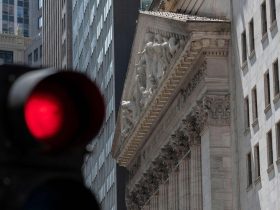The U.S. economy likely expanded rapidly in the third quarter as consumer spending soared, residential construction jumped, and business investment remained strong.
Economists forecast U.S. real gross-domestic product grew at a 3.8% annual rate from July to September, consensus expectations from FactSet show, marking a major acceleration from the second quarter’s revised 2.1% pace. That would mark the fastest quarter for growth since late 2021, when the aftermath of the Covid-19 economic reopening and a massive inventory rebuild among companies pushed growth to a 7% rate.
The Commerce Department will release GDP figures at 8:30 a.m. Thursday.
Forecasts do vary widely The New York Fed’s Nowcast model is expecting 2.5% growth for the third quarter, while the Federal Reserve Bank of Atlanta’s closely watched GDPNow tool is suggesting 5.4% growth. An upside or downside surprise from the consensus is possible.
Still, any figure that falls between the New York and Atlanta forecasts will still reflect both an acceleration from the second quarter, and a strong expansion.
BNP Paribas
economists note that third-quarter growth could be strong enough to push forecasts for the fourth quarter higher as well.
A strong third quarter of growth would reflect a positive contribution from every major component of the GDP, economists say, including falling imports, rising exports and a restocking of inventories. Consumer spending will be the most significant growth factor, pushing overall GDP considerably up as rising wages helped fuel strong demand in areas such as travel, leisure and hospitality.
Despite major strength in the third quarter, however, the rampant expansion is likely to slow through the end of the year, and fourth-quarter growth is on track to come in far smaller than the third quarter, economists say. Consumer spending in particular is likely to slow because of a combination of slowing income growth and ongoing “price fatigue,” as Gregory Daco, chief economist with EY-Parthenon, put it.
Plus, much of what consumers were spending on in the third quarter was likely one-off tickets and experiences, such as tickets to Taylor Swift and Beyoncé concerts, or to the Barbie and Oppenheimer movies, Daco says.
“They are typical examples of spending that isn’t renewed,” he says. “So you actually get a negative contribution to growth in the following quarter because spending doesn’t occur.”
Other economic headwinds are growing, too: Geopolitical tensions are lifting uncertainty and could dampen demand. More households are spending more money on debt payments. And the Federal Reserve’s own efforts to slow the economy are beginning to have an impact, one that will grow the longer interest rates remain elevated.
“We do not see this significantly above-potential pace of growth persisting in a restrictive monetary policy setting,” the BNP Paribas team wrote.
Nonetheless, a strong growth figure for the third quarter will come as good news for the economy, suggesting economic recession isn’t imminent and that consumers broadly remain healthy. But given the backward-looking nature of the GDP data, even eye-popping strength in the latest data will be unlikely to sway the Fed to raise interest rates when policy makers next meet Oct. 31-Nov. 1.
Officials have heavily telegraphed that they are all but certain to hold rates steady during that meeting at the current range of 5.25% to 5.5% despite recent strong economic data, largely because they want to proceed cautiously as they wait to see how the economy continues to react to higher rates.
“I would expect and hope that the Fed is now well aware of the strength that we had in the third quarter but also acknowledges the fact that the third quarter is over,” Daco says. “We are now looking at a very different picture when it comes to economic activity.”
Write to Megan Cassella at megan.cassella@dowjones.com
Read the full article here










Leave a Reply